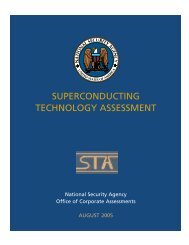Untitled - nitrd
Untitled - nitrd
Untitled - nitrd
- No tags were found...
You also want an ePaper? Increase the reach of your titles
YUMPU automatically turns print PDFs into web optimized ePapers that Google loves.
PREPRINT COPYCyber Security and Information Assurance (CSIA)NITRD Agencies: NSF, DARPA, OSD and DoD Service research organizations, NSA, NIST, NASAOther Participants: DHS, DISA, DOT, FAA, FBI, IARPA, State, Treasury, TSWGCSIA focuses on research and development to prevent, resist, detect, respond to, and/or recover from actions thatcompromise or threaten to compromise the availability, integrity, or confidentiality of computer- and networkbasedsystems. These systems provide both the basic infrastructure and advanced communications in every sectorof the economy, including critical infrastructures such as power grids, emergency communications systems,financial systems, and air-traffic-control networks. These systems also support national defense, national andhomeland security, and other vital Federal missions, and themselves constitute critical elements of the ITinfrastructure. Broad areas of concern include Internet and network security; confidentiality, availability, andintegrity of information and computer-based systems; new approaches to achieving hardware and softwaresecurity; testing and assessment of computer-based systems security; and reconstitution and recovery ofcomputer-based systems and data.President’s 2010 RequestStrategic Priorities Underlying This RequestR&D priority areas for the CSIA agencies range from fundamental investigation of scientific bases for hardware,software, and system security to applied research in security technologies and methods, approaches to cyberdefense and attack mitigation, and infrastructure for realistic experiments and testing. Emphases include:Foundations: Foundations of cyber security as a multidisciplinary science; new models, logics, algorithms, andtheories for analyzing and reasoning about reliability, security, privacy, and usability; new analyzable anddecomposable security models; harmonization of risk (security and safety) modeling frameworks; assured andtrustworthy systems and compositions of systems from untrustworthy components; cyber security metrics;social and technical dimensions of a trustworthy computing future; foundation for modeling risk andcontributing factors in characteristics and behaviors of organizations, groups, and individuals – includingsemantics of trust; secure software engineering and development; cryptography and quantum computationresistantcryptographyApplied and information infrastructure security: Secure virtual platforms; assured information sharing;security for emerging network technologies (mobile, wireless, pervasive computing); identity managementprinciples, frameworks, standards, models, and technologies; security automation; secure protocols;vulnerability detection and mitigationSituational awareness and response: Full-spectrum, multi-layer cyber attack indications and warnings,detection, assessment, and attribution; assured operations in high threat environments; security eventvisualization; cognitive policy-based security systems and managementInfrastructure for R&D: Testbeds, ranges, tools, platforms, repositories to support cyber securityexperimentationHighlights of RequestFoundationsCyber Trust Centers: Team for Research in Ubiquitous Secure Technology (TRUST); A Center for Correct,Usable, Reliable, Auditable, & Transparent Elections (ACCURATE); Collaborative Center for InternetEpidemiology & Defenses (CCIED); Trustworthy Cyber Infrastructure for the Power Grid (TCIP); SecurityThrough Interaction Modeling (STIM, now SAFE) – NSFSecure software engineering: Metrics for cost-benefit and risk analysis tools (e.g., OSD’s QuERIES); identifyoperational security practices for early phases of systems development life cycle; formal methods forvalidation, verification of composable systems; scalable secure systems; lightweight analysis – NSF, OSD,NIST, DHSSoftware protection: Function extraction technologies to automate the computation of software behavior;embedded software security technologies; software cross-domain security; malicious code detection,mitigation, and prevention; software anti-tamper – DARPA. OSD, ARO, CERDEC, ONR, NSA6NITRD Supplement to the President’s FY 2010 Budget










